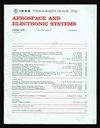基于特征三角的电气设备多模态图像配准
IF 5.7
2区 计算机科学
Q1 ENGINEERING, AEROSPACE
IEEE Transactions on Aerospace and Electronic Systems
Pub Date : 2024-12-11
DOI:10.1109/TAES.2024.3514602
引用次数: 0
摘要
红外和可见光成像对于电气设备的故障检测至关重要,但它们在分辨率、视场和光谱上的差异给准确的图像配准带来了挑战。目前的方法通常存在准确性差、处理时间长或无法正确注册的问题。提出了一种基于特征三角形的电气设备多模态图像配准方法。将轮廓分为开放轮廓和封闭轮廓,计算点曲率来识别特征,根据曲率半径构造特征三角形,利用三角形质心确定主方向。该方法演示了缩放、平移和旋转下的不变性。我们使用公开可用的数据集和我们自己的数据集来评估建议的方法,并与最先进的技术进行主观和客观的比较。该方法的平均配准精度为0.1117,平均处理时间为8.834 s。红外和可见光图像的显著曲率轮廓比分别为0.251和0.193,特征点比分别为0.610和0.527。实验结果表明,与现有方法相比,该方法具有更高的配准精度和更低的计算开销。本文章由计算机程序翻译,如有差异,请以英文原文为准。
Multimodal Image Registration of Electrical Equipment Based on Feature Triangle
Infrared and visible imaging are crucial for detecting faults in electrical equipment, but their differences in resolution, field of view, and spectrum pose challenges for accurate image registration. Current methods often suffer from poor accuracy, lengthy processing times, or failing to register properly. This article proposes a multimodal image registration method for electrical equipment using feature triangles. It categorizes contours into open and closed contours, computes point curvatures to identify features, constructs feature triangles based on curvature radii, and determines principal directions using triangle centroids. The method demonstrates invariant properties under scaling, translation, and rotation. We evaluated the proposed method using both publicly available datasets and our own datasets, conducting both subjective and objective comparisons with state-of-the-art techniques. The proposed method achieved an average registration accuracy of 0.1117 and an average processing time of 8.834 s. For the infrared and visible images, the significant curvature contour ratios were measured at 0.251 and 0.193, respectively, while the feature point ratios were found to be 0.610 and 0.527. The experimental results demonstrate superior registration accuracy and reduced computational overhead compared to existing methods.
求助全文
通过发布文献求助,成功后即可免费获取论文全文。
去求助
来源期刊
CiteScore
7.80
自引率
13.60%
发文量
433
审稿时长
8.7 months
期刊介绍:
IEEE Transactions on Aerospace and Electronic Systems focuses on the organization, design, development, integration, and operation of complex systems for space, air, ocean, or ground environment. These systems include, but are not limited to, navigation, avionics, spacecraft, aerospace power, radar, sonar, telemetry, defense, transportation, automated testing, and command and control.

 求助内容:
求助内容: 应助结果提醒方式:
应助结果提醒方式:


